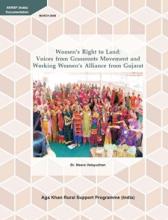Land Library
Bienvenido a la biblioteca de Land Portal. Explora nuestra amplia colección de recursos de acceso abierto (más de 74.000), que incluye informes, artículos de revistas científicas, trabajos de investigación, publicaciones revisadas por pares, documentos jurídicos, vídeos y mucho más.
/ library resources
Showing items 1 through 9 of 2477.The IFAD Policy on Improving Access to Land and Tenure Security has been formulated to: (a) provide a conceptual framework for the relationship between land issues and rural poverty, acknowledging the complexity and dynamics of evolving rural realities; (b) identify the major implications of that
The position paper provides an updated insight on the role that urban agriculture can play in pursuing the Millennium Development Goals and more specifically MDG 1 and 7, related to poverty reduction, food security, and environmental sustainability.
Traditionally, the land tenure system in Southern Ethiopia may be characterised by patrilineal inheritance and virilocal residence. Young girls have very little influence over when and whom to marry.
This publication, from the Global Land Tool Network, presents a mechanism for effective inclusion of women and men in land tool development and outlines methodologies and strategies for systematically developing land tools that are responsive to both women and men’s needs.
The Working Group on Women and Land Ownership (WGWLO) is a Gujarat-based network of 23 NGOs set up 2003 in a context of increasing recognition of women’s land rights in international conventions, national planning and policies, as well as research, that has not resulted in a reduced gen
[From the Executive Summary] Women’s access to and control over land is crucial for improving their status and reducing gender inequalities, which in turn are critical factors in reducing the prevalence of poverty, malnutrition and AIDS.
This report for GTZ, published in May 2008, analyses the potentials and risks of Jatropha plantation. With regards to land issues, it highlights the risks of land degradation and intransparent investment and lists a number of large-scale investors.
The paper elucidates the current structure of university education in Belarus and particularly emphasises available levels of education.






